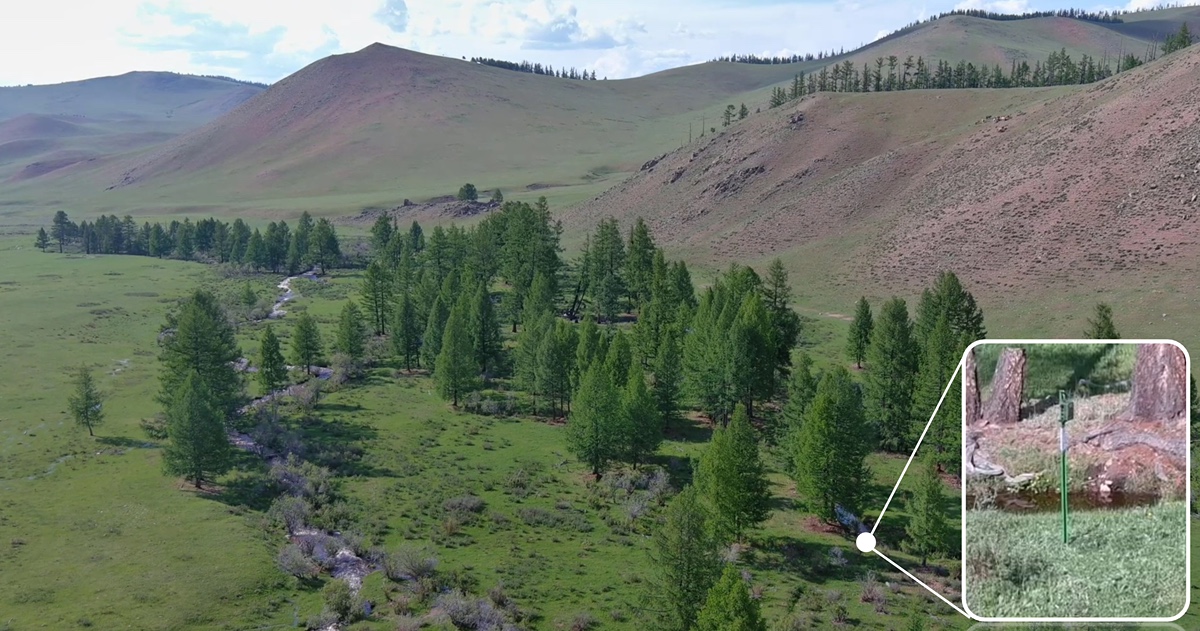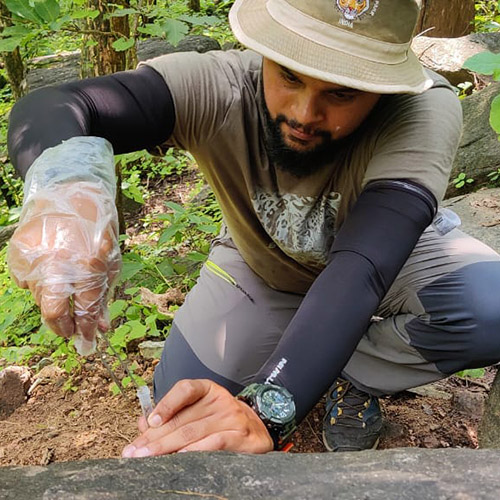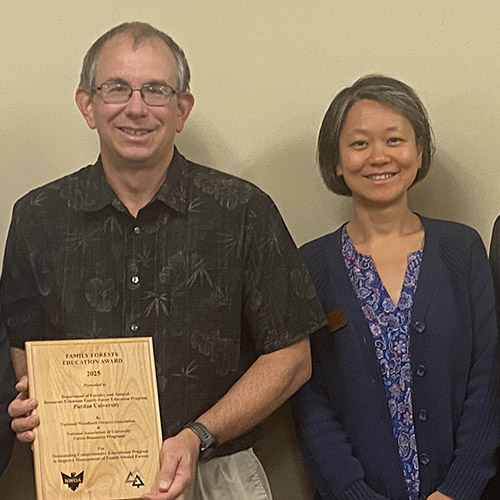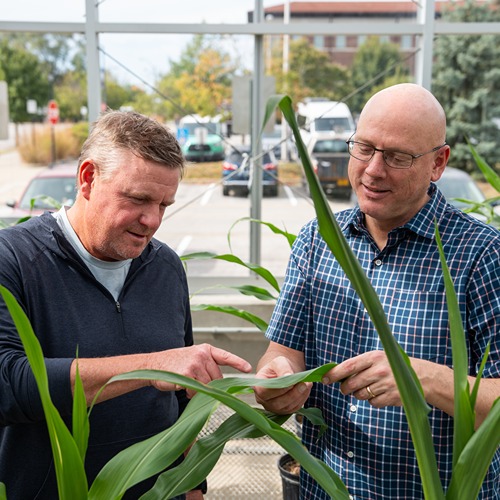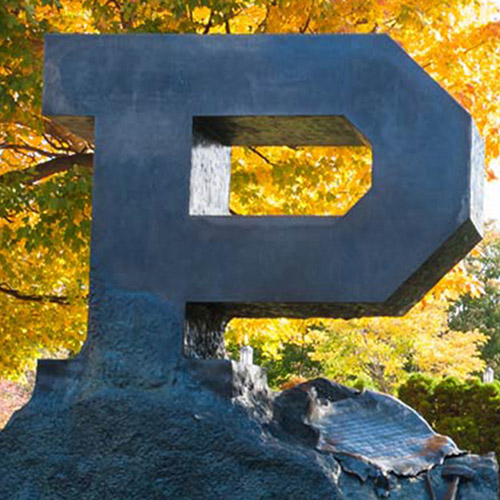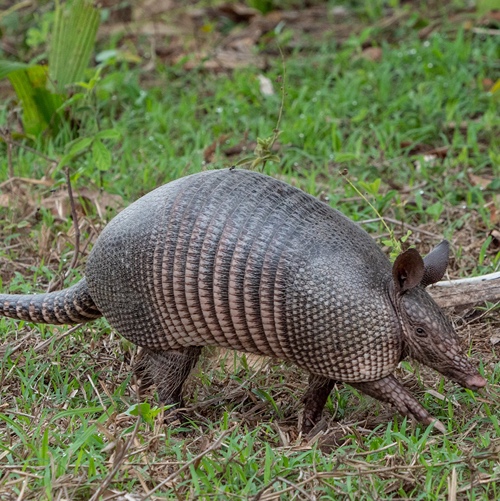Help the Hellbender Research Program Honored with Friends of Conservation Award
The Help the Hellbender research program, based in Purdue Forestry and Natural Resources, was honored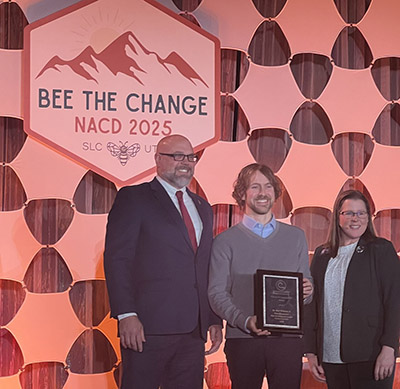 with the National Association of Conservation Districts (NACD)’s Friends of Conservation Award at the organization's annual meeting in Salt Lake City on Feb. 11.
with the National Association of Conservation Districts (NACD)’s Friends of Conservation Award at the organization's annual meeting in Salt Lake City on Feb. 11.
"This award means a lot to our program, not just because it's always nice to be recognized, but because it demonstrates how our program has successfully expanded beyond just conserving wildlife,” Purdue extension wildlife specialist Nick Burgmeier said. “It's a recognition of our commitment to working with partners and stakeholders to benefit both our wildlife and human communities. When we work together to protect the soil and the land farmers depend on, we are also working together to protect the water and the land wildlife, including Hellbenders, depend on."
In its award recognition, the NACD noted:
“Led by Dr. Rod Williams and Nick Burgmeier, the Help the Hellbender Project combines research, education, and conservation to enhance the Hellbender's habitat and promote awareness. Through a captive-rearing program, the project is helping to restore the dwindling population of hellbenders in Indiana's Sinking Blue River Watershed. The Help the Hellbender Project's multifaceted approach has benefited both local communities and wildlife now and into the future.”
The NACD award follows a county level Friends of Conservation Award from the Washington County Soil & Water Conservation District in February 2023 and an Indiana state level award in January 2024.
The Help the Hellbender team also received the Outstanding Achievement Award, Academic Sector, from the Indiana Water Resources Association in June 2023.
In March 2023, they received the Budd Denneman Partners in Conservation Excellence award from the Indiana Department of Natural Resources Division of Fish and Wildlife to honor outstanding conservation efforts. The Help the Hellbender partnership is a collaboration between the Indiana DNR and Purdue University with funding support from the U.S. Fish & Wildlife Service and partners in local governments, universities, non-governmental organizations and zoos that are working to recover the state-endangered hellbender. The partnership is the largest and most comprehensive group working to recover an imperiled amphibian in Indiana.
The eastern hellbender (Cryptobranchus alleganiensis alleganiensis) is a large, fully aquatic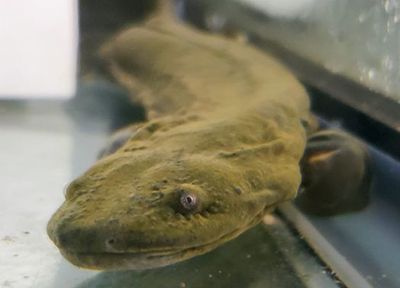 salamander, nicknamed the snot otter, water dog, devil dog, Allegheny alligator and water eel among other things. Their decline in Indiana started in the early-to-mid 1900s because of habitat loss and poor water quality. Hellbenders play an important role in aquatic ecosystems and are indicators of clean water.
salamander, nicknamed the snot otter, water dog, devil dog, Allegheny alligator and water eel among other things. Their decline in Indiana started in the early-to-mid 1900s because of habitat loss and poor water quality. Hellbenders play an important role in aquatic ecosystems and are indicators of clean water.
For the last 17 years, the Help the Hellbender team has been researching eastern hellbenders, spearheading regional conservation efforts and advancing hellbender captive propagation, or the rearing of this ancient animal in captivity for their eventual return to the wild.
Each fall, eggs are gathered from rivers and streams in southern Indiana, Kentucky and Ohio and split among the Help the Hellbender lab and zoo partners, to be raised in captivity. At age three or four, the juvenile salamanders are returned to the wild with hopes of increasing the population and encouraging breeding.
Since the project began in 2007, 900 animals have been returned to the Blue River and surrounding areas, accounting for a 670% increase over the original population estimate from 2008-2010. Another 850 hellbenders, not including newly acquired eggs, are currently being raised in captivity.
The Help the Hellbender partnership had a major breakthrough in the summer of 2023 with the documentation of a larval hellbender in the Blue River while conducting routine surveys. This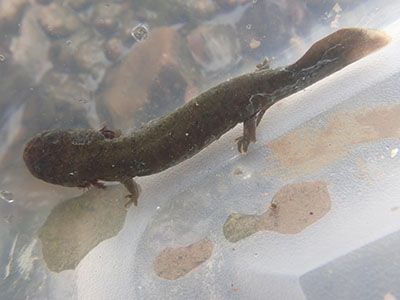 discovery is significant because over the past four decades, only adult hellbenders have been documented in the Blue River. The presence of a larval salamander suggests that conservation efforts and rearing programs are accomplishing their goals for the recovery of this endangered species.
discovery is significant because over the past four decades, only adult hellbenders have been documented in the Blue River. The presence of a larval salamander suggests that conservation efforts and rearing programs are accomplishing their goals for the recovery of this endangered species.
Over the years, the lab has procured nearly $7 million in grants to fund engagement and research. All told, the Help the Hellbender lab has produced 33 research publications, eight extension publications and 12 extension videos to share about the species as well as how other researchers and the general public can aid hellbenders and other species by keeping waterways clear of obstructions and clean.
Given the multifaceted nature of hellbender declines and the broad scope of the problem, diverse stakeholders needed to be engaged to form a collaborative interdisciplinary team of organizations and conservation groups with a common goal. Consequently, a key feature of the program is the partnerships that have been cultivated. Help the Hellbender has assembled a diverse group of 24 partners, including federal, state, and local agencies, non-profits, industry, academic, zoological, and outreach-focused groups, to address the recovery of a threatened aquatic salamander. The HTH team provided the leadership necessary to bring these groups together to forge a successful path to conserve and recover the hellbender in Indiana.
The Help the Hellbender lab, now under the leadership of Dr. Jason Hoverman, is actively collaborating with the Indiana Department of Natural Resources, Indiana Division of Fish and Wildlife, the Nature Conservancy and the Sam Shine Foundation as well as several other partners across 13 states on a number of conservation projects and educational opportunities for teachers, children, farmers and more.
The newest addition to the partnership’s conservation efforts is the Farmers Helping Hellbenders project, which offers funding opportunities to agricultural producers in the Blue River – Sinking Watershed to implement conservation practices on their land to assist with topsoil retention, the improvement of aquatic resources and the recovery of Eastern Hellbenders.
The project, which is made possible by a $2.7 million in funding from the U.S. Department of Agriculture’s Regional Conservation Partnership Program, aims to improve hellbender habitat in a four-county region in south central Indiana, the only remaining habitat for hellbenders in the state, by expanding the use of agricultural conservation practices that lead to decreased sedimentation in local rivers systems. Williams talks more about hellbenders and the Farmers Helping Hellbenders project in this YouTube video.
The program is already producing astounding results. When the first two years of signed contracts (2023 and 2024) are complete, they will result in:
- Reduction of sediment by 2,568,680 pounds per year
- Reduction in nitrogen by 9,040 pounds per year
- Reduction in phosphorus by 2,374 pounds per year
Eligible producers and forest landowners who wish to implement conservation practices on their land should discuss their options with their local district conservationist. For more information or to submit an application, contact your local district conservationist by visiting Farmers.gov/Service-locator.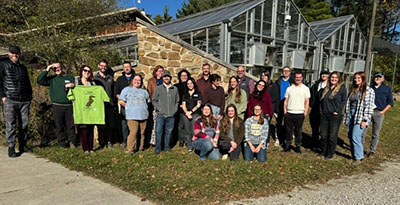
An in depth look at the hellbender program’s success is available through the story “Rebuilding Indiana’s Hellbender Habitat” from the Natural Resources Conservation Service.
Help the Hellbender and Farmers Helping Hellbenders project partners include: Columbian Park Zoo, Crawford County Cattleman's Association, Crawford County Soil and Water Conservation District (SWCD), Cryptobranchid Interest Group, Fort Wayne Children's Zoo, Floyd County SWCD, Harrison County Cattleman's Association, Harrison County SWCD, Indianapolis Zoo, Indiana Department of Environmental Management (IDEM), Indiana Department of Natural Resources, Kentucky Department of Fish and Wildlife, Mesker Park Zoo and Botanic Gardens, Natural Resource Conservation Service, Office of Kentucky Nature Preserves, Ohio State University, Sam Shine Foundation, Texas Tech University, The Nature Conservancy, Thomas More University, United States Fish and Wildlife Service, Washington County Cattleman's Association, Washington County SWCD and Wallace Center at Winrock International.
